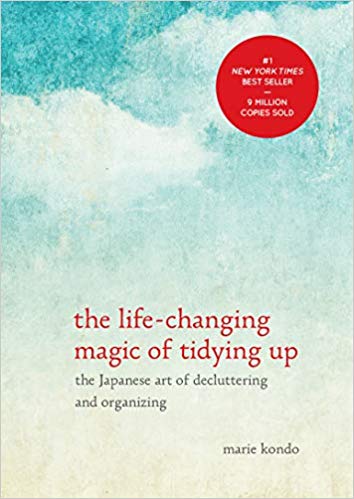

This article is an excerpt from the Shortform summary of "The Life-Changing Magic of Tidying Up" by Marie Kondo. Shortform has the world's best summaries of books you should be reading.
Like this article? Sign up for a free trial here .
The Marie Kondo method of cleaning asks one major question: “Does it spark joy?” But it’s not clear what this really means, and when it applies and doesn’t.
How Does the Konmari Method work?
First, let’s review how the Konmari method works, to know how sparking joy fits into it.
Konmari has you go category by category. For each category, gather all the items together in a giant pile, discard first, then organize what’s left.
Here’s the correct order that makes things mentally easier:
- Clothes
- Books
- Papers
- Komono (miscellany)
- Sentimental items
For each category, go through every single item like so:
- Pick it up.
- Ask yourself, does this item spark joy?
- If it does, keep it.
- If it doesn’t, thank it for everything it’s done for you. Then move it to the discard/donate pile.
Does It Spark Joy?
When you pick up each item in your hands, ask, “Does this spark joy?” If it does, keep it. If it doesn’t, discard it. This is the simplest way to approach your belongings.
How to know when something sparks joy: it usually happens immediately. We handle something with care, our eyes light up, and we feel a warmth in our hearts and a smile on our face.
- Pick up something you know you love, and see how it feels. This is the feeling you want everything around you to spark. If everything around you sparked joy, you’d be happier–everywhere you looked would bring a smile to your face.
When something doesn’t bring us joy, we usually pause and look at something for longer, turn our heads, frown. Our faces are tight, and we feel more confusion inside than joy.
Using your joy as the deciding factor will help avoid the pitfalls of the previous section.
It’s a subtle difference, but approaching it this way will turn it into a positive experience (identifying what gives you joy and choosing that) instead of a negative one (getting rid of things).
You should feel a spark of joy when you touch an item–this is a surefire sign that you should keep it. But remember that there might be totally rational reasons that you need to keep something that doesn’t spark joy–something like necessary medications that keep you alive and healthy.
- (Shortform note: You obviously shouldn’t discard things that you absolutely need, like medications, even if they don’t spark joy. For instance, a lot of critical book reviewers mentioned having work clothes that they needed but didn’t spark joy. If you have a uniform you can’t change, you need to keep that uniform. But if you have a dress code and therefore have some freedom in terms of what you wear, wouldn’t it be better to find work clothes that do spark joy?)
Resistance in Sparking Joy
Sometimes we find ourselves resistant to the idea of throwing something away, even if it doesn’t necessarily spark joy and we don’t absolutely need it. Here are some of the most common mental blocks, and how to deal with them.
If you encounter something that makes you resist discarding it: remember how you came to own this object. When did you get it, and why, and what meaning did it have for you then? Ask yourself if this object has a real purpose in your life now. Chances are the answer is no, and this object has already fulfilled its purpose in your life.
Sometimes objects come into our lives to teach us that we didn’t like this thing, or didn’t need it, or that it gave us joy to purchase it but not to use it. These are still valuable lessons.
- Every object has a role to play in your life, even if that role is to reveal that actually you don’t like that style of clothing, even though you really thought you did–why else would you not have worn it?
Our unwillingness to discard something usually indicates either an attachment to the past or anxiety about the future. We all want to remember our past and we all want a stable future–but when we let attachment to the past or anxiety about our future dictate our decisions, we focus on everything but the present.
- If you discover, through tidying, that you have a deep attachment to the past, it’s probably affecting other areas of your life, like your job and your relationships. Same goes for anxiety about the future.
- There are only three ways to deal with your belongings: do it now, do it sometime, or avoid it until you die. It’s better to face things now, if we can, so that we don’t have to deal with them later.
Getting rid of things we don’t need anymore isn’t shameful or a waste. Just because you give a home to a lot of objects doesn’t mean you’re taking care of them. It really means the opposite: you have too many things to take care of any of them…
———End of Preview———

Like what you just read? Read the rest of the world's best summary of Marie Kondo's "The Life-Changing Magic of Tidying Up" at Shortform . Learn the book's critical concepts in 20 minutes or less .
Here's what you'll find in our full Marie Kondo summary :
- The psychological benefits of tidying
- How to Tidy the Konmari method
- How to deal with Clothing, Books, Papers, and Sentimental Items
- ...and much more






